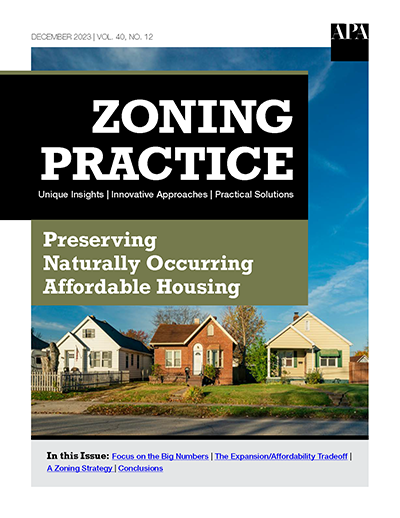Spotlight on Zoning Practice
Can Zoning Save Naturally Occurring Affordable Housing (NOAH)?

Zoning reform works. There is mounting evidence that residential upzoning can increase the supply and decrease the average cost of housing. The bad news is these aggregate gains are modest and — in some contexts — come with a net loss in naturally occurring affordable housing (NOAH), that is, housing affordable to low– and moderate-income households without requiring some form of subsidy.
Given that the vast majority of low-income renter households depend on unsubsidized housing and that we are unlikely to build our way out of the housing crisis any time soon, can zoning play a greater role in protecting NOAH?
Earlier this year, APA's Equity in Zoning Policy Guide challenged planners to consider designing zoning overlays to protect vulnerable residential areas from speculative development and displacement. In the December issue of Zoning Practice, "Preserving Naturally Occurring Affordable Housing," Don Elliott, FAICP, examines just what this might look like in practice.
A Tough Dilemma
Liberalizing zoning to permit a wider variety of housing types in a wider range of locations is an essential component of a more holistic strategy for meeting the nation's housing needs. But as Elliott points out, the housing supply grows very slowly, and new units are often more expensive than smaller, older homes. Absent subsidies or a well-calibrated inclusionary housing policy, tearing down a NOAH unit to build multiple new units will not increase the supply of housing affordable to lower-income households.
According to Elliott, this means many communities face a very difficult choice when it comes to formulating a zoning strategy to promote housing affordability. They can prioritize boosting overall supply, which will likely have a moderating effect on housing costs but lead to the displacement of some lower-income households. Or they can prioritize preserving existing NOAH units, with the risk of limiting growth in the local housing supply.
The Pro-NOAH Approach
For communities who want to prioritize preserving NOAH, historic preservation regulations provide a clear potential model. As Elliott explains, these regulations provide a legal precedent for using zoning to limit investment in specific areas. A NOAH preservation base or overlay district could function quite similarly to historic districts. Instead of protecting architectural features, a NOAH district would target the features that keep homes affordable. It might limit floor area expansions or the dollar value of investments and require an extra level of scrutiny for demolition requests.
According to Elliott, this approach would not necessarily need to undermine wider efforts to boost housing supply. Local officials could apply these standards to areas where average household incomes or assessed home values are below a specific threshold. This would severely limit speculative purchases and development. However, as Elliott notes, it isn't a risk-free strategy. Housing quality may deteriorate faster than it otherwise would. But this isn't guaranteed, and under current conditions, a NOAH protection strategy may be a logical complement to upzoning in areas with higher housing costs.
Subscribe to Zoning Practice

Each issue of Zoning Practice provides practical guidance for planners and land-use attorneys engaged in drafting or administering local land-use and development regulations. An annual subscription to ZP includes access to the complete archive of previous issues.
Top image: peterspiro, iStock / Getty Images Plus


